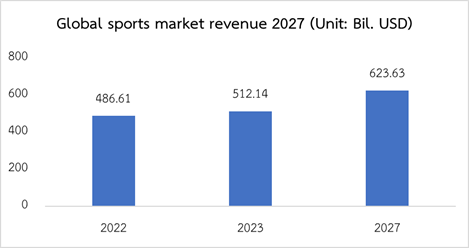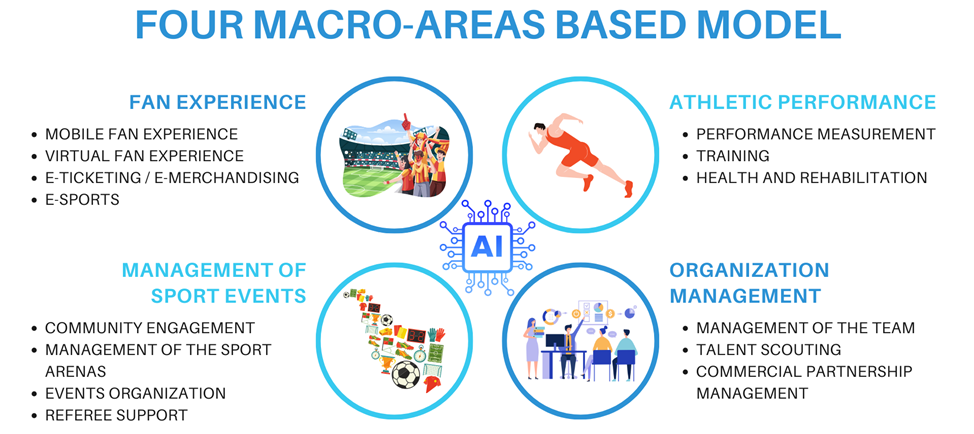Author
Chanon Limpasitipon
Sra Limsawaddiwong
Artificial intelligence (AI) is rapidly transforming traditional processes and boosting productivity across various industries, and the sports sector is no exception. In fact, the sports industry could be considered a frontrunner in this technological revolution. This article explores how AI is reshaping the economic landscape and redefining the experience of sports.
- The Global Sports Market: Booming Growth Fueled by AI
The global sports market is experiencing significant growth, with revenue in 2023 expected to reach 512.14 billion USD, representing a 5.2% increase compared to 2022. This positive trend is expected to continue, with analysts projecting a compound annual growth rate (CAGR) of 21.77% between 2023 and 2027, resulting in a projected market valuation of over 623.63 billion dollars by 2027.
Picture 1: The expected revenue of global sports market

This impressive growth can be partly attributed to the increasing impact of artificial intelligence (AI) in the sports sector. The global AI in sports market, valued at 2.1 billion USD in 2022, is expected to experience a significant CAGR of 30.10% from 2024 to 2031. According to Cognitive Market Research, North America is a leader region in AI sports market share.
Picture 2: AI in Sports Market Share (%) by Region (2019-2031)

- Understanding Framework of Digital Transformation in Sports
AI is transforming the way sports are watched, played, cheered, and enjoyed. To gain a holistic view of its impact, we will explore a four-area model developed by Mosele (2018). This model categorizes the effects of digital innovation in sports into fan experience, athletic performance, organizational management, and sports event management.
Picture 3: Four Macro-areas Based Model of AI in Sport Industry

- Fan Experience: AI has significantly transformed how sports teams interact with their global fan base, enriching the experience both at home and during live events. Digital platforms like smartphone apps, streaming services, and VR/AR enable personalized interactions, offering a range of services and content tailored to individual preferences. This shift empowers previously inactive fans by allowing them to vote on in-game aspects or analyze post-game data. The growing involvement of tech giants like Facebook and Amazon in live streaming underscores the crucial role of digital connections. Furthermore, the rise of e-sports and dynamic ticketing presents teams with new opportunities to expand their fan base and maximize revenue. While AI strives to create individualized and immersive experiences, catering to the diverse needs and preferences of global fan bases remains a challenge.
- Athletic Performance: Digital technologies are transforming how sports teams manage and evaluate athlete performance. Advanced analytics, powered by the vast amount of data generated during games and training, provide invaluable insights into athletes’ skills. This data, coupled with the expertise of experienced sport consultants, allows teams to make data-driven and targeted decisions regarding training regimens. Modern equipment and wearable technology play a crucial role in this process, enabling the creation of personalized training programs tailored to each athlete’s specific physical needs. The data-driven personalization is key in today’s fiercely competitive environment, where even minor improvements can significantly impact results and financial rewards. The performance optimization also covers health monitoring which lead to in-depth assessments of injury prevention.
- Management of Sport Events: Community engagement is crucial for sports events, fostering connections between local and global fans. Digital platforms like MAKEACHAMP enable fans to support athletes and teams through charitable initiatives, even financing player signings in some cases. Share ownership schemes are another way some teams deepen fan loyalty, though they can add management complexity. Beyond digital connections, creating physical hubs also strengthens fan communities. Initiatives like the NBA café in Barcelona offer fans a stadium-like experience. Modern venues like Barcelona’s Palau Blaugrana are prioritizing fan interaction with innovative designs. This includes differentiated ticketing, offering a range of experiences to suit diverse preferences and maximize revenue for teams. Additionally, security technologies like facial recognition and crowd analytics enhance safety within stadiums while optimizing traffic flow and access. Finally, technology is also playing a role in officiating with systems like Hawk-eye and VAR. These advancements promote transparency and fairness in sports by assisting referees in making more objective decisions.
Picture 4: Sport Crowdfunding Platform

- Organization Management: Team management, talent scouting and commercial partnerships are the key areas that significantly impacted by AI. Teams leverage specialized Information Systems to gather and analyze vast amounts of data on athlete health and performance. This data empowers them to make informed decisions regarding player management and training. Moreover, Digital technology has revolutionized talent scouting. Instead of relying solely on in-person scouting trips, teams now have access to extensive online databases and match video libraries. This allows for efficient player recruitment and improved match preparation. In addition, The rise of digital channels has opened doors for wider audience reach, leading to a booming sports sponsorship market valued at $70 billion in 2017 (and projected to grow 15% annually). Advanced analytics now enable brands to maximize online interactions and tailor communication campaigns during sporting events. With sponsors demanding measurable returns, digital tools provide insights into fan reactions to brand exposure, allowing brands to optimize their sponsorships. Additionally, global internet advertising, particularly mobile advertising, is surpassing traditional TV advertising, reflecting a shift in sponsorship tactics towards social media and online channels.
- AI in Sports: Examples from Golf, Football, and Formula One
AI is rapidly transforming the world of sports, from enhancing player performance to revolutionizing fan engagement. We specifically select golf as a representative for individual sports, football as a representative for team sports, and Formula One as a representative for human and machine sports.
Golf: Artificial intelligence (AI) is leaving its mark on the game of golf, impacting both how players are trained and how fans experience the sport. Golf simulators like Trackman provide professionals with deep data analysis of their swing mechanics and ball flight, leading to more informed training and a potential competitive edge. This data-driven approach has also required instructors to adapt their teaching methods, incorporating data interpretation alongside traditional swing mechanics coaching. While this has undoubtedly improved training, it has also opened doors for indoor golf simulation, offering beginners and enthusiasts a convenient way to play and practice regardless of weather or location. However, this shift towards indoor golf may pose a threat to traditional courses, potentially leading to decreased player numbers and impacting jobs like caddies and maintenance staff. On the other hand, the growing popularity of indoor facilities might create new job opportunities in areas like facility management, technical support, and sales.
Moreover, AI’s influence extends beyond training, transforming how fans experience the game. Live streaming technology allows fans to conveniently access tournaments and follow real-time updates online, potentially leading to a decline in ticket sales for live events. While this provides greater accessibility and convenience for fans, it can negatively impact event finances, potentially affecting player awards, event quality, and even local businesses that rely on tournament revenue.
Football: The most notably mark of AI on football is the introduction of Video Assistant Referee (VAR) technology. VAR aims to improve decision-making accuracy by allowing referees to analyze crucial moments through AI-powered systems, minimizing controversial calls and human error. For example, the recent Qatar World Cup 2022 exemplifies AI’s growing presence in football. VAR technology, with 12 tracking cameras per stadium, showcased its ability to track player movements and aid decision-making. While some praise VAR for promoting fairness, others raise concerns about its effect on game flow and the inherently subjective nature of certain calls. This integration of AI highlights the ongoing debate around striking a balance between technological advancements and preserving the human element of the game. Another AI innovation showcased in the World Cup was the “Al Rihla” ball, equipped with AI chips that send data 500 times per second. These chips provide real-time data on ball movement, player performance, and other aspects, offering deeper game insights and improved analysis accuracy. This technology has also created a new market for AI-powered footballs, with growing demand from professional leagues, training academies, and fans. This increased demand opens up new economic opportunities for manufacturers, potentially creating new jobs in production and research and development. However, concerns exist around the potential replacement of referees by AI in the future, impacting traditional officiating roles and employment within the industry.
Picture 5: Al Rihla football

Formula One: The beautiful combination between human and machine, has been greatly influenced by AI. Especially in the areas of car design and technical advancements. The vast amount of data collected from F1 cars, equipped with over 300 sensors, empowers engineers to optimize performance, fuel efficiency, and aerodynamics using AI tools like machine learning and simulations. These innovations, driven by the pursuit of perfection in F1, often “trickle down effect” to everyday cars, leading to advancements in materials, engine efficiency, safety features, and aerodynamics. This not only enhances the driving experience and promotes environmental sustainability and safety, but also stimulates economic growth and job creation. The need for a skilled workforce to create, manufacture, and maintain these complex systems arising from F1 technology integration into regular cars fosters talent specialization and opens up job opportunities in the advanced automotive industries. Ultimately, AI’s impact in F1 goes beyond the race track, driving innovations that benefit both the sport and society at large by contributing to a more sustainable, safer, and technologically advanced future for the automotive industry.
- Supporting Thailand’s Sports Industry in the Age of AI
As artificial intelligence (AI) transforms the sports industry globally, Thailand’s government can play a crucial role in ensuring its continued success. A multi-pronged approach is key. Firstly, investing in upskilling and reskilling programs through partnerships with academia and industry leaders is essential. These programs, focusing on data analysis, technological integration, and responsible AI use in sports, can equip existing professionals to adapt and thrive in the new landscape. Additionally, targeted programs should address potential job displacement in traditional roles like golf course staff. Secondly, fostering innovation and entrepreneurship is vital. By implementing financial incentives like low-interest loans and tax breaks for businesses investing in AI-driven sports technologies or indoor sports facilities, the government can encourage the creation of new markets and jobs. Moreover, supporting startups through dedicated initiatives can foster a culture of creativity and push the boundaries of technological application in sports. By adopting these strategies, the Thai government can not only mitigate the challenges of AI but also unlock its potential to drive economic growth, technological advancement, and job creation, ensuring a flourishing sports industry in the years to come.
- Conclusion
While artificial intelligence (AI) is revolutionizing the sports industry, enhancing experiences, optimizing performance, and streamlining management, it also presents a crucial question: how can we ensure this progress benefits everyone? Governments will play a critical role in fostering responsible AI implementation by supporting workforce reskilling and upskilling initiatives, promoting innovation alongside ethical considerations, and encouraging inclusive growth across the industry. By proactively addressing potential challenges and harnessing AI’s potential, we can ensure a future for sports where technology empowers both players and fans, while fostering economic opportunities and human well-being.
References
- Dharmadhikari, S. (2023, December). AI in Sports Market Report 2024 (Global Edition). Cognitive Market Research. Retrieved March 5, 2024, from https://www.cognitivemarketresearch.com/ai-in-sports-market-report
- Mosele, J. (2018). Artificial Intelligence in the Sport Industry [Master Degree, Politecnico Di Milano]. https://www.politesi.polimi.it/bitstream/10589/142501/1/ARTIFICIAL%20INTELLIGENCE%20IN%20THE%20SPORT%20INDUSTRY_JACOPO%20MOSELE.pdf
- Avcontentteam. (2024, February 27). How is AI Powering the Future of Sports? Analytics Vidhya. https://www.analyticsvidhya.com/blog/2023/05/how-is-ai-powering-the-future-of-sports/#h-examples-of-ai-in-sports
- Bangkok Post. (2022, April 8). Upskilling Thailand’s human resources for the future of work. Bangkok Post. https://www.bangkokpost.com/business/general/2292326/upskilling-thailands-human-resources-for-the-future-of-work
- Holm, L. (2022, September 18). CFD in F1 (What it means and why it’s important). Formulapedia. https://formulapedia.com/cfd-in-f1/
- Luna. (2023, October 17). The top F1 technology features in our everyday cars – Singapore’s 24/7 Car Sharing Service. Singapore’s 24/7 Car Sharing Service. https://getgo.sg/blog/top-f1-technology-features-in-everyday-cars/#:~:text=F1%20teams%20have%20been%20at,cars%20for%20people%20like%20us.
- Bhardwaj, N. (2022, December 6). Did you know that the FIFA World Cup ball has a chip inside it? Here’s how it works. India Today. https://www.indiatoday.in/cryptocurrency/story/did-you-know-that-the-fifa-world-cup-ball-has-a-chip-inside-it-heres-how-it-works-2305971-2022-12-06
- O’Brien. (2023, August 8). Golf simulators or real golf courses? | Golf Swing Systems. Golf Swing Systems. https://www.golfswingsystems.co.uk/blog/golf-course-vs-golf-simulator/
- Statista. (2023, July 13). Global sports market revenue 2027. https://www.statista.com/statistics/370560/worldwide-sports-market-revenue/


Chanon Limpasitipon
Author

Sra Limsawaddiwong
Author
